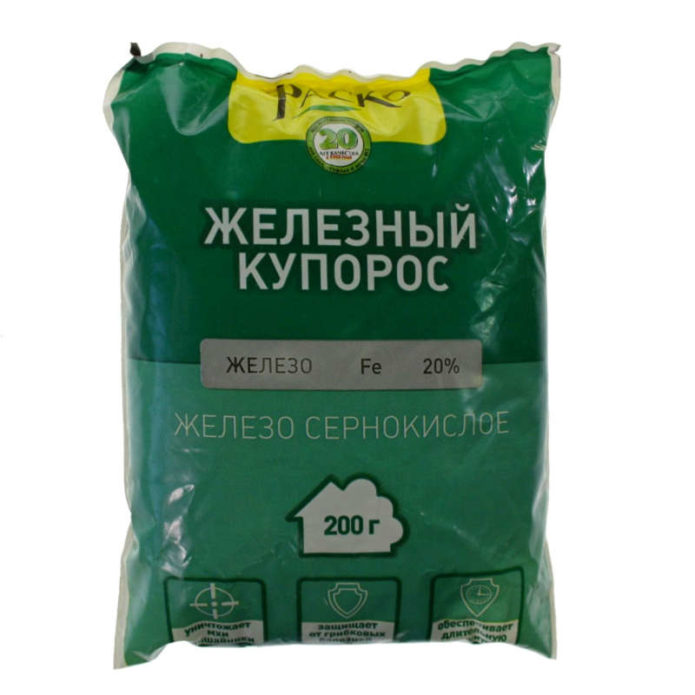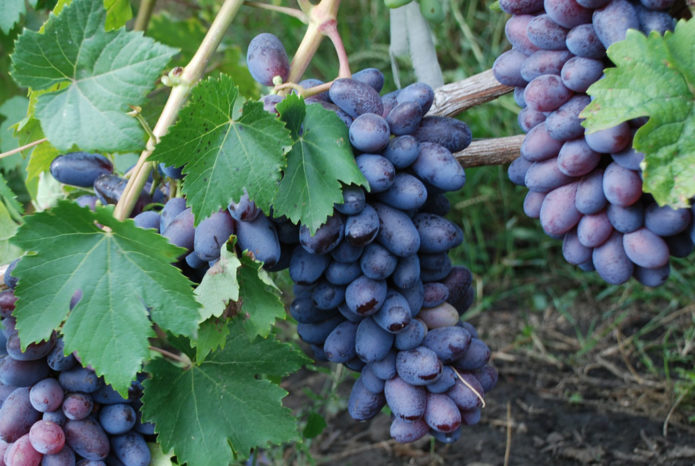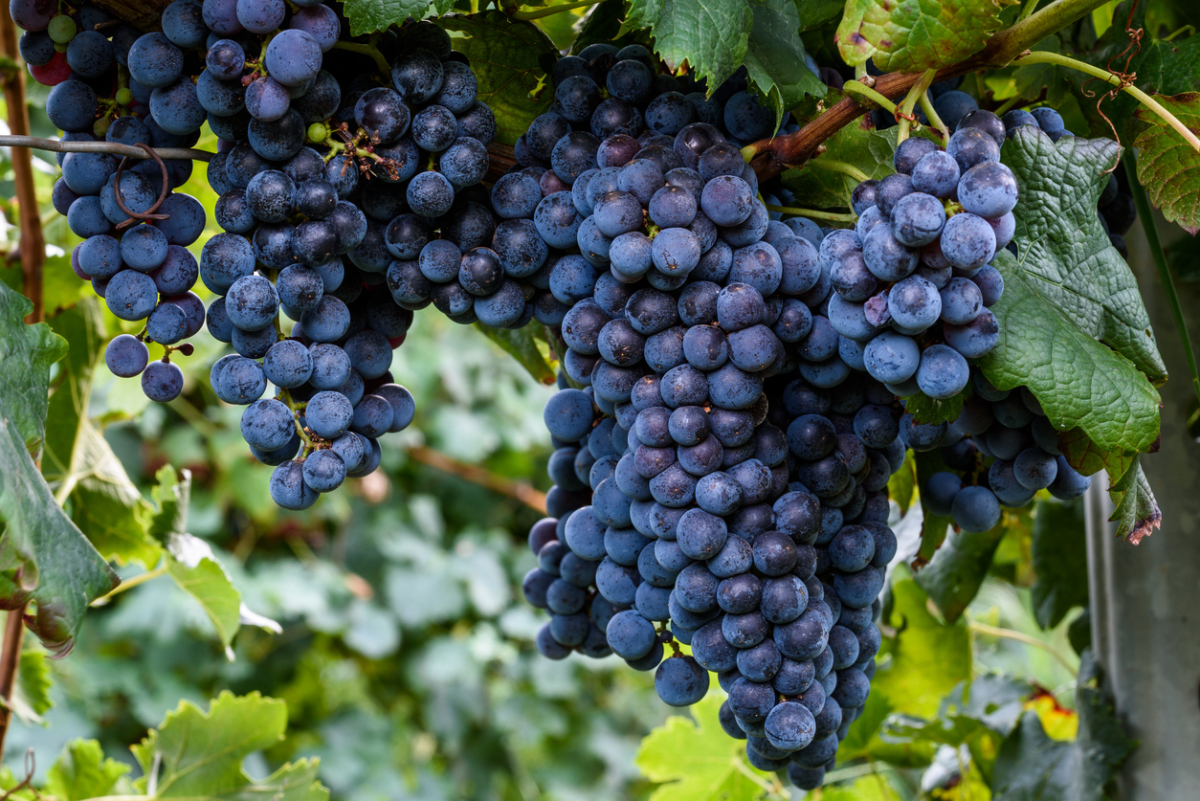Baikonur is a fairly young grape variety intended for cultivation in most regions of our country with different climatic conditions. It is suitable for both large farms and small summer cottages. The variety is famous for its high yield and excellent taste of early ripening beautiful berries.
Content
Breeding history, description and characteristics of the Baikonur grape variety
The Baikonur grape has been known for only a few years. But its popularity is growing rapidly every year. This is due to the remarkable properties of both the variety as a whole and its fruits.
The origin of the Baikonur grapes
Baikonur is a grape variety created by an amateur breeder. This is how the national history develops that in recent decades the most successful grape varieties have been leaving the hands of enthusiasts who devote all their free time to their hobby. One of these amateurs is the breeder E. G. Pavlovsky, who 6 years ago released a very successful hybridization of the famous grape varieties Krasotka and Talisman. Immediately after the appearance of Baikonur, great success and popularity were predicted for him.
In the very first year, Baikonur was named a promising variety, since it took only the best positive qualities from the original parental forms. The beauty gave him a wonderful presentation and transportability of berries, and the Talisman - large-fruited, delicious taste and resistance to adverse weather conditions. Baikonur, created as a result of their crossing, has the ability to adapt to any climatic conditions and can be grown both in the south and in the central regions.
Of course, since the variety is still new, all the nuances of its behavior are unknown. So, statistics on his attitude to various grape diseases has not yet been collected, but so far, in this regard, Baikonur receives only positive reviews. His seedlings and cuttings are in high demand on the market.
Description of the variety
The bush near Baikonur is very tall and fast-growing: young shoots can reach 4 meters per season. It is propagated both by cuttings and by grafting into a stem or shoots of other varieties, the yield does not depend on this. Leaves are ordinary, large, bright green. Without rationing the harvest, that is, removing part of the bunches, of which a lot is tied, the vine may not have time to ripen by winter, but the bush seeks to preserve all the berries and bring them to a ripe state. Frost resistance at the level of most modern varieties: grapes can withstand temperatures of -23 aboutFROM.
The variety is self-fertile: due to the bisexuality of the flowers, replanting of other bushes for the purpose of pollination is not required. In terms of ripening, it can be classified as very early: it happens that the first berries ripen by the end of July, but usually in the middle lane the main harvest takes place in mid-August.At the same time, the bunches do not ripen at the same time, the last copies are removed in the fall.
The mass of the bunches is also uneven: if the fastest rarely weigh more than 0.5 kg, then those ripening by autumn reach a kilogram. The bunches are generally not very dense, but lush and beautiful. The harvest is very high, and to maintain it, the bushes require reinforced supports: trellises based on strong posts and several rows of thick horizontally stretched wire.
The fruits of Baikonur are very large, their shape is close to cylindrical, the length is up to 4 cm. The berry mass reaches 16 g. The main color is dark purple, but in one bunch there may be specimens of almost black and dark purple; while they are all in a state of approximately the same ripeness. There is a thin dark waxy coating on the berries, which protects them from accidental damage and enhances the crop's ability to be transported over long distances.
Berries, when eaten, emit a characteristic crunch, since the skin on them is dense, but it is thin, edible and tasty. In rainy weather, the berries do not crack. Sugar content is about 20%, tasters regard the taste of berries as unique. Muscat notes are completely absent, but they are replaced by an unusual fruity aroma. The acid content is small, but it allows you to use the fruits not only for direct fresh consumption, but also for various preparations, including the preparation of wines.
Another positive quality is that the variety does not require immediate harvesting when it ripens: the bunches can stay on the bushes for a long time without deteriorating their taste and appearance. This allows us to recommend Baikonur to those winegrowers who grow crops for sale. The bunches are well stored and transported.
Video: Baikonur grapes in full ripening
Features of planting and cultivation of the Baikonur grape variety
Baikonur grapes differ little in agricultural technology from other varieties of a similar purpose and ripening period, some features are introduced only by the very large size of its bushes: because of their solidity, the distance to neighboring bushes of the same or another variety, as well as to any other garden plants, is in no way may be less than three meters.
The cultivar has an excellent rooting rate of cuttings and can be easily propagated by this well known technique.
Experiments of enthusiasts, even in the middle lane, have proven that there is no need to grow seedlings from cuttings in an apartment: even with the spring planting of last year's awakened cuttings, they manage to take root immediately in the garden and form good seedlings by autumn.
Like any grape, Baikonur requires that it be planted in the brightest area, protected from cold winds. Not picky about soils, but the best are light, breathable. Groundwater should not come closer than two meters to the surface of the earth. On any soil, abundant fertilization with well-rotted manure is required. The optimal planting time depends on the region, but it is best to plant in April.
The depth of the planting pit is chosen depending on the type of soil: from 60 cm on light to 80 cm on clay. In arid regions, even greater depth is required. In the case of heavy soils, a drainage layer in the pit is required. Due to the powerful growth of the bushes, Baikonur requires the introduction of increased doses of fertilizers to the bottom of the pit. It is planted like any other grape, leaving no more than two buds on the surface. Water and mulch abundantly around the seedling.
Compared to other grape varieties, Baikonur and watering requires more frequent and abundant, especially during the harvest. If the summer is dry, then light watering is possible during berry picking, but in normal weather, watering is not carried out 2-3 weeks before they ripen.Top dressing is performed every year: humus in early spring, wood ash in summer and foliage spraying with weak solutions of mineral fertilizers shortly before flowering and immediately after it. As for the fight against diseases, to date, no cases of serious diseases of this grape have been described, since most gardeners must carry out preventive spraying with iron or copper sulfate in early spring and preparations such as Ridomil Gold in the several-leaf stage.

Apparently, it will not be possible to do without preventive spraying in the cultivation of Baikonur
Correct pruning of bushes and rationing of the crop are required. The Baikonur vine has short internodes, therefore, at least 10 well-developed eyes are left on each fruitful shoot. Although, on the other hand, even the formation of its bushes is still debated, because the variety has not been fully investigated.
Shelter for the winter is carried out, like most modern frost-resistant grape varieties. In the south, Baikonur can winter without shelter, in other regions the vines in the fall, after leaf fall, must be removed from the trellises and wrapped in light non-woven material or covered with spruce branches.
Video: Baikonur harvest on the bushes
Advantages and disadvantages of the variety
If we compare Baikonur with similar grape varieties, then it should be recognized that it is one of the best in the range of very early fruiting varieties. It is difficult to give very high marks, since the variety is still little studied, but there is an opinion that it is not at all worse than, for example, Libya, and the well-known Arcadia may eventually be surpassed in the rating.
The main advantages of the variety are:
- very early ripening and at the same time the duration of fruiting;
- the safety of berries on the bushes without deteriorating quality;
- excellent, peculiar taste;
- large-fruited;
- abundant harvests;
- attractive appearance;
- the resistance of berries to cracking;
- ability to transport and long-term storage;
- lack of peas;
- buncation of flowers;
- good frost resistance;
- adaptability to unfamiliar climatic conditions;
- resistance to major diseases, as well as flying insects.
So far, few disadvantages have been described, for example:
- the presence in the berries of several not very easily detachable seeds;
- insufficient, today, awareness of the variety in terms of propensity to disease: perhaps from this point of view Baikonur in unfavorable years can spoil the impression of itself.
Reviews
The berry is very large, up to 4.5 cm. It easily holds out, has a nipple-shaped berry, of a very beautiful dark color. The bunch is semi-friable, it looks elegant. The grapes at the moment are almost ripe (the ripening level is about GF Rochefort), you can judge by the stone on my hand, which is only one for such a large berry. Not bad! The pulp is dense, juicy, harmonious taste, but not quite simple. I'm sorry, I find it difficult to describe the taste of GF Baikonur berries more precisely, because today I have tried a lot of all kinds of berries of various GF at the Pavlovsky breeding site ... Everything has mixed ... first fruiting. Well, I agree that there is no need to answer for everyone ... But I personally will have such grapes on my site.
I have been observing the hybrid form B-9-1, the current name of Baikonur, for the second year. Last year the harvest was on the seedling. This year I compared the results of fruiting on a seedling and on a grafted bush, the results are close, on a more powerful grafted bush the berries are larger. It keeps very well on the bushes, ripened at the end of July, and I removed the bunch on August 17, and the next day after a heavy downpour - no changes. I think that a couple of left bunches will happily survive until the festival in Yalta. The berry at Baikonur is purple-red with a dark blue, almost black tint.One of the best new products I've seen in recent years.
Baikonur bore fruit for me for the first time. In the green state, the rain did not burst, although it flooded us decently. In adulthood, he also behaved stably. There was only one problem - uneven coloration of the berries in the bunch. I liked the taste very much, but there was no crunch in the berry, there was marmalade.
Video: expert review of the variety
The agricultural technology of Baikonur grapes does not differ from the agricultural technology of other table grape varieties; the variety can be recommended to most summer residents who have mastered the basic techniques of working in the garden. The excellent commercial qualities of the berries make it possible to consider Baikonur a variety created both for individual small plots and for growing in large farms for commercial use.




